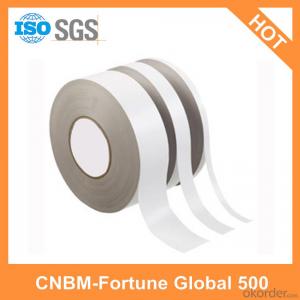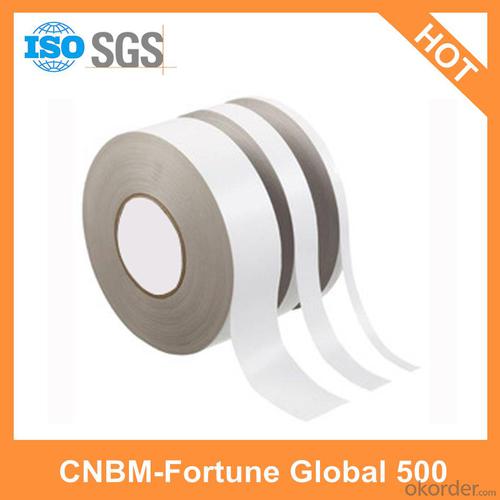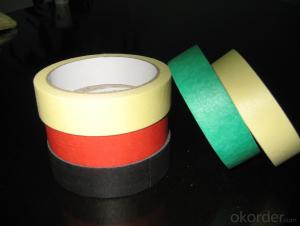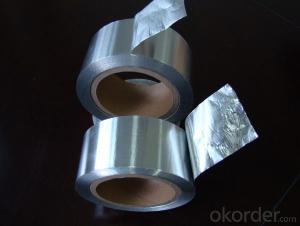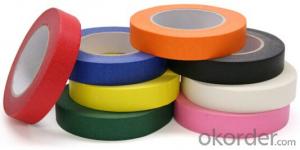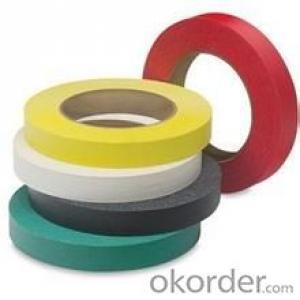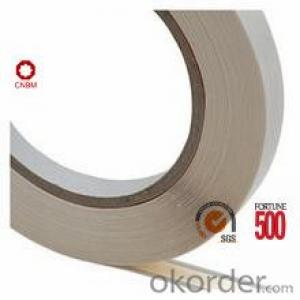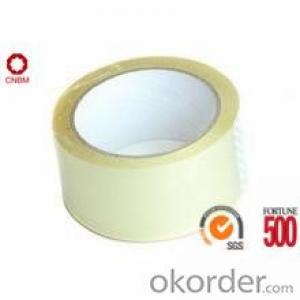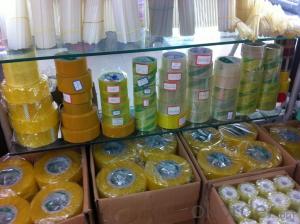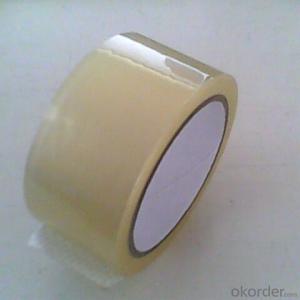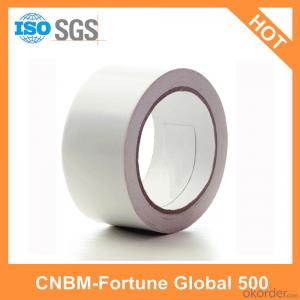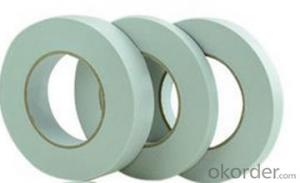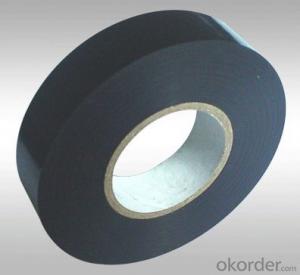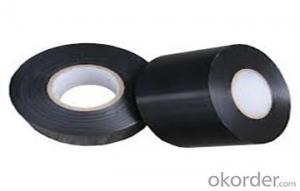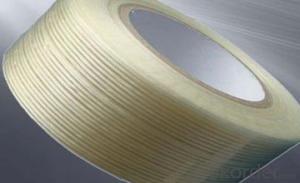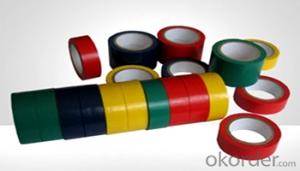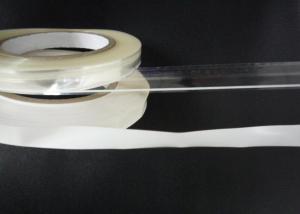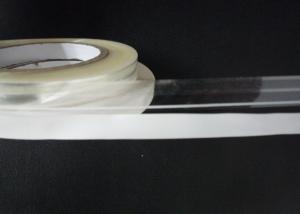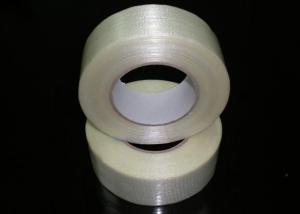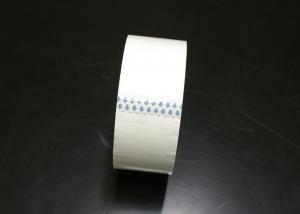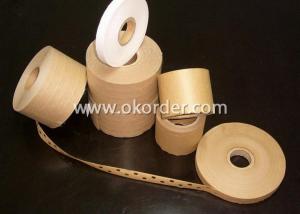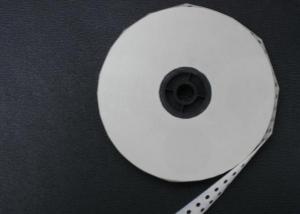Embossed Tape Packaging - Single Sided Tissue Adhesive Multiple Use Antistatic Tape
- Loading Port:
- Tianjin
- Payment Terms:
- TT OR LC
- Min Order Qty:
- 1000 roll
- Supply Capability:
- 500000 roll/month
OKorder Service Pledge
OKorder Financial Service
You Might Also Like
1.Product Description
Desc | Double Sided Tissue Tape Antistatic Multiple Use | |
Item No. | DT-22 | |
18G/Backing | 18g tissue | |
Thickness | 120mic | 140mic |
Tack | ≥20# | ≥24# |
180° Peeling | ≥16N/25mm | ≥20N/25mm |
Holding power | ≥8hrs | |
Temperature resistance | 60℃ | |
Color | Clear/Yellow | |
Usage | Embroidery | |
2.Packaging & Delivery
Packaging Details:
Polybag package or customized package
Jumbo roll: max length: 800m
Max width: 1260mm (usable 1240mm); 1040mm (usable 1020mm)
Slit roll: width/length available upon request
Delivery Detail: 10-25 working days after deposite receipt
Delivery Detail:
Shipped in 15-25 working days after payment
3.Certification and Factory
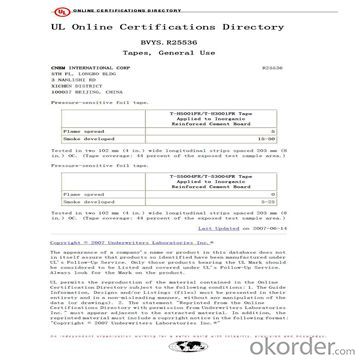
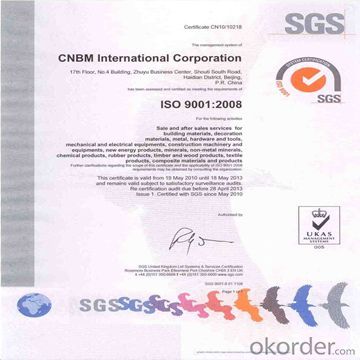
4.Our service
• Your inquiry related to our product & price will be replied within 24hours.
• Well-trained & experienced staff are to answer all your inquiries professional in English of course.
• Working time: Mon-Sun 8:30am - 5:30pm (China Time)
• OEM is highly welcomed. We have strong R&D team here to help.
• Your business relationship with us will be confidential to any third party.
• Good after-sale service offered, please get back if you got question
5.FAQ:
How to guarantee our quality?
1). Before produce: send samples for checking.
2). During producing: send photos for producing.
How about Packaging?
1). Can be printed customer's logo on the paper core and cartons.
2). Normal packaging, special packaing as your request, such as individual shrink with logo card, barcode lable, blister card or as request.
- Q: What are the considerations for using packaging tape on painted surfaces?
- When using packaging tape on painted surfaces, it is important to consider the type of paint used and its durability. Some paints may not adhere well to the tape, causing it to peel off and damage the surface. Additionally, strong adhesive tapes can leave behind residue or even strip off the paint when removed. Therefore, it is advisable to test a small inconspicuous area before applying the tape extensively and to opt for low adhesive or painter's tape for better results.
- Q: Is packaging tape safe for use on sensitive or confidential documents?
- No, packaging tape is not safe for use on sensitive or confidential documents. It can damage or leave residue on the documents, potentially compromising their confidentiality or integrity.
- Q: What are the considerations for using packaging tape on fragile items like ceramics?
- Several important considerations should be kept in mind when using packaging tape on fragile items such as ceramics. To begin with, it is crucial to carefully select the appropriate type of packaging tape. It is advisable to look for tape that is specifically designed for fragile items or delicate surfaces. This type of tape generally possesses features such as gentle adhesive and high tensile strength, which can help prevent damage or residue on the ceramics. Handling the ceramics with care during the application of the tape is also of great importance. It is important to avoid applying excessive pressure or force that could potentially result in cracking or breaking. Additionally, ensuring that the surface of the ceramics is clean before applying the tape is essential for proper adhesion. Consideration should also be given to the amount of tape that should be used. While it is necessary to adequately secure the ceramics, using an excessive amount of tape can add unnecessary weight and potentially harm the fragile item. It is advisable to use just enough tape to securely hold the ceramics in place without putting excessive strain on them. Furthermore, it is recommended to use additional protective materials in conjunction with the packaging tape. Bubble wrap, foam sheets, or packing peanuts can provide extra cushioning and protect the ceramics from potential impact or vibrations during transit. Lastly, it is crucial to label the package as fragile to ensure that handlers are aware of its delicate contents. This can help minimize the risk of mishandling and provide an extra layer of caution during transportation. In conclusion, when using packaging tape on fragile items like ceramics, it is important to consider factors such as selecting the appropriate tape, handling the ceramics with care, using the right amount of tape, employing additional protective materials, and clearly labeling the package as fragile. By taking these factors into account, the safe transportation of fragile ceramics can be ensured.
- Q: Can packaging tape be used for sealing foam or bubble wrap?
- Yes, packaging tape can be used for sealing foam or bubble wrap. Packaging tape is designed to have a strong adhesive that adheres well to various surfaces, including foam and bubble wrap. By applying packaging tape to the edges or seams of foam or bubble wrap, you can securely seal and protect your items during shipping or storage. It is important to ensure that the tape is applied properly and firmly to provide a tight seal and prevent the foam or bubble wrap from coming loose.
- Q: How does packaging tape perform in high-temperature conditions?
- Packaging tape generally performs well in high-temperature conditions, but its effectiveness may vary depending on the specific type and quality of the tape. Most packaging tapes are designed to withstand a range of temperatures and are typically heat-resistant up to a certain degree. However, it is important to note that extreme temperatures, particularly those exceeding the tape's specified heat resistance limit, can affect its adhesive properties and overall performance. In high-temperature conditions, the adhesive on packaging tape may soften or weaken, leading to reduced bonding strength and potential tape failure. This can result in packages opening or becoming less secure during transit or storage. Furthermore, heat can cause the tape to become less flexible, making it more prone to cracking or breaking. Hence, it is crucial to select packaging tape that is specifically designed for high-temperature environments if you anticipate exposure to extreme heat. Certain types of packaging tape, such as fiberglass-reinforced or high-temperature resistant tapes, are better suited for withstanding high temperatures. These tapes are often made with special adhesives and materials that offer enhanced heat resistance and improved performance in extreme conditions. They are designed to maintain their adhesive strength, bonding capability, and structural integrity even when exposed to elevated temperatures. In summary, while packaging tape can generally withstand high-temperature conditions, its performance may be compromised if subjected to extreme heat. Using tapes specifically designed for high-temperature environments can help ensure optimal performance and securely seal packages even in challenging conditions.
- Q: Is packaging tape waterproof?
- Typically, packaging tape possesses waterproof properties. Its design aims to resist moisture effectively and create a formidable seal, thereby preventing water infiltration into the package. Nonetheless, it is crucial to acknowledge that the degree of waterproofing can vary depending on the quality and type of packaging tape employed. Certain tapes may offer a more reliable seal compared to others, hence it is advisable to opt for a tape explicitly crafted for packaging and sealing applications.
- Q: How is packaging tape different from regular tape?
- Packaging tape is different from regular tape in several ways. Firstly, packaging tape is designed for heavy-duty use and is specifically made to securely seal boxes and packages for shipping or storage. Regular tape, on the other hand, is generally used for lighter tasks such as gift wrapping or arts and crafts. Secondly, packaging tape is typically wider and thicker than regular tape, providing better strength and durability. This ensures that packages remain securely sealed during transportation and handling, reducing the risk of damage or tampering. Furthermore, packaging tape often has specific features that regular tape may not have. For example, some packaging tapes are designed to be water-resistant or have reinforced fibers for added strength. These features are crucial in protecting packages from moisture, ensuring that the tape does not easily tear, and providing extra security for valuable or fragile items. Lastly, packaging tape often comes in larger rolls or dispensers, allowing for efficient and continuous application. This is especially important when sealing multiple packages or dealing with larger items. Regular tape, on the other hand, is typically available in smaller rolls or individual pieces, making it more suitable for smaller-scale tasks. In summary, packaging tape differs from regular tape in terms of its intended use, strength, durability, specific features, and size options. Its purpose is to provide a reliable and secure seal for packages during transportation and storage, making it an essential tool in the logistics industry.
- Q: Are there any eco-friendly options for packaging tape?
- In today's market, there are various eco-friendly options for packaging tape. Typically, traditional packaging tapes are made from plastic materials like polypropylene or PVC, which are harmful to the environment and not biodegradable. However, there have been developments in creating eco-friendly alternatives to tackle this issue. Some of these options include: 1. Packaging tape made from paper: These tapes are crafted from renewable resources like paper and natural adhesives. They are both biodegradable and compostable, making them a sustainable choice for packaging requirements. 2. Gummed paper tape, also known as water-activated tape: This type of tape is made from paper and requires water to activate the adhesive. It forms a strong bond when applied to boxes and provides tamper-proof sealing. Additionally, water-activated tape is biodegradable and can be recycled along with the packaging it is used on. 3. Biodegradable and compostable tape: These tapes are manufactured using plant-based materials such as cellulose or polylactic acid (PLA). They are designed to naturally break down over time, minimizing their impact on the environment. Some options are certified as compostable, meaning they can be added to compost piles or sent to composting facilities. 4. Recycled plastic tape: Although traditional plastic tapes are not environmentally friendly, there are recycled plastic tape options available in the market. These tapes are produced using recycled plastic materials, reducing the demand for new plastic and promoting a circular economy. When searching for eco-friendly packaging tape, it is crucial to consider certifications such as the Forest Stewardship Council (FSC) for paper-based tapes or the Biodegradable Products Institute (BPI) certification for compostable tapes. By opting for these alternatives, individuals and businesses can minimize their environmental impact and contribute to a more sustainable future.
- Q: Are there any specialty packaging tapes for specific applications?
- Yes, there are specialty packaging tapes available for specific applications. These tapes are designed to cater to specific needs and requirements in various industries. Some examples of specialty packaging tapes include: 1. Double-sided tapes: These tapes have adhesive on both sides and are commonly used for mounting purposes, such as attaching posters or signs to surfaces. 2. Tamper-evident tapes: These tapes leave a visible mark or pattern when removed, indicating that the package has been tampered with. They are commonly used for sealing sensitive or valuable items during transportation. 3. Filament tapes: These tapes have fiberglass strands embedded in them, providing high tensile strength. They are commonly used for bundling heavy items or reinforcing packages that require extra strength. 4. Masking tapes: These tapes have low adhesive strength and are easily removable without leaving residue or damaging surfaces. They are commonly used for masking off areas during painting or for temporary holding applications. 5. Printed tapes: These tapes can be customized with specific messages, logos, or branding to enhance the presentation of packages and promote brand awareness. 6. Cold temperature tapes: These tapes are designed to withstand extremely low temperatures and are commonly used in cold storage facilities or for shipping goods that require refrigeration. 7. Hazard warning tapes: These tapes are brightly colored and have warning messages or symbols printed on them. They are commonly used to mark hazardous areas or indicate potential dangers. These are just a few examples of the many specialty packaging tapes available in the market. Each tape is designed to meet specific requirements, ensuring the safe and secure packaging of different products or materials in various industries.
- Q: Can packaging tape be used for sealing packages with sharp edges or corners?
- Yes, packaging tape can be used for sealing packages with sharp edges or corners. Its strong adhesive properties and durability make it suitable for securing boxes and ensuring that the package remains intact, even when subjected to sharp edges or corners.
Send your message to us
Embossed Tape Packaging - Single Sided Tissue Adhesive Multiple Use Antistatic Tape
- Loading Port:
- Tianjin
- Payment Terms:
- TT OR LC
- Min Order Qty:
- 1000 roll
- Supply Capability:
- 500000 roll/month
OKorder Service Pledge
OKorder Financial Service
Similar products
Hot products
Hot Searches
